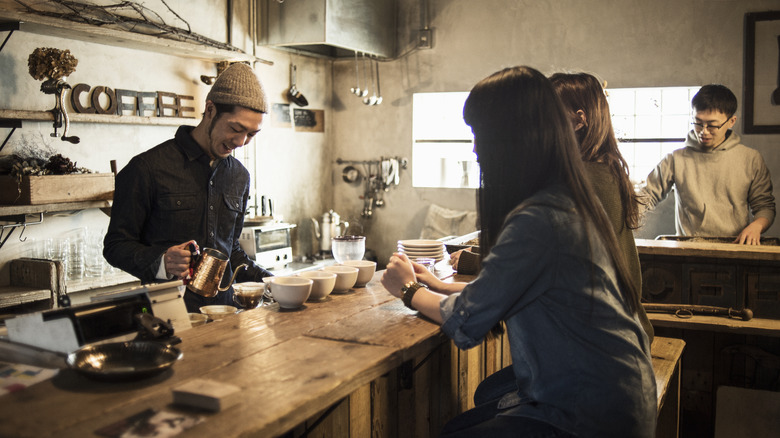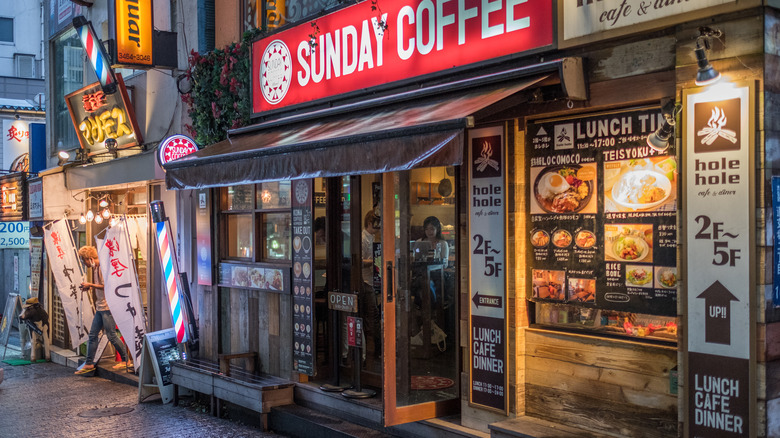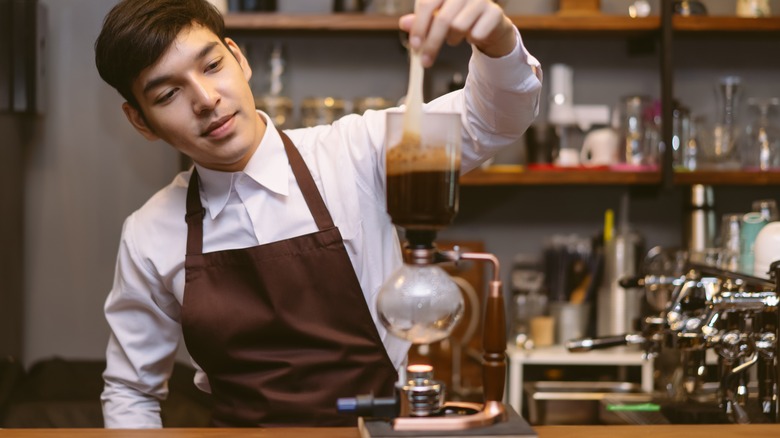How Coffee Shop Culture Emerged In Japan
Tea has always been an iconic part of Japanese food and beverage culture, so much so that two of Japan's best known hot beverages are green tea and matcha. But this certainly doesn't mean there hasn't been room for coffee culture to take root and thrive, which it has done for more than a century.
Unlike tea which is grown across many parts of the country, coffee is an import and it arrived Japan during the 1800s by way of Dutch traders. The brew of the time would have been made with beans that were roasted until they were dark. These were then ground and soaked in hot water, before the resulting beverage was served. This coffee was strong, bitter, and dark — and it was more of a medicinal tonic than a drink to be enjoyed.
It was thanks to a student named Eikei Tei, who also went by the name Tsurukichi Nishimura, that a European coffee shop concept was first introduced to Japan. Tei had studied in Europe, and wanted to bring the idea of the French café back to his home country, so that others might have a place to hang out and chat. While the idea was a good one, the late 1800s was not the best time for budding coffee houses. Tei was ahead of his time and Japan's first ever coffee shop went out of business after just five years.
The birth of the kissaten
It wasn't until the 1920s that the idea of a "kissaten" came about, a word that translates to "tea drinking shop." A product of the Showa era, which took place between 1926 and 1989, the kissaten began as a place where people could sip tea, enjoy a snack and a smoke, and exchange ideas with others — just as Eikei Tei envisioned decades before. Over time, and after tea was replaced by coffee, the kissaten became a place to catch a simple, straightforward cup of java.
But just as coffee began growing in popularity, World War II broke out, and one of the first things the government did was ban coffee imports, putting an end — albeit temporary — to this favored type of gathering place. The import ban saw coffee supplies dry up, forcing many of these shops to close. Thankfully, the ban didn't last long; the war ended in 1945 and the coffee import ban was lifted five years later, allowing the kissaten to make its second comeback. Japanese coffee shops remained popular until the late 1980s and it is said that at the height of their popularity, Japan had more than 150,000 different privately-owned kissaten shops all over the country.
Japan's traditional coffee houses perfected the art of making coffee
Following home and the work place, the kissaten was considered to be the third most important place for the Japanese clientele who frequented them. It was a place to enjoy the company of friends, a place to relax, and a place to listen to classical music ("meikyoku" kissa) or jazz (jazz kissa), depending on what type of music the owner fancied. These establishments had special business permits allowing them to serve light meals even if they couldn't serve alcoholic drinks; by contrast, cafés were allowed to offer a selection of alcohol.
On the coffee front, the kissaten became a place to experiment. Because Japanese patrons prefer brewed coffee, owners continue to play with different ways of brewing coffee to come up with new options. These traditional shops have adapted the western technique of siphon coffee and refined it so there are now different ways to prepare the beverage which are specific to Japanese coffee brewers, from adding grounds to highly specific stirring techniques. Owners are also known for roasting their own beans — dark and strong in the style that suited their earliest customers.
While the genesis of home grown chains like Doutour and the arrival of international giants like Starbucks might have hurt its popularity, the independently-owned kitassan is making a comeback, particularly among those looking for unique coffee experiences with a nostalgic, retro vibe.


